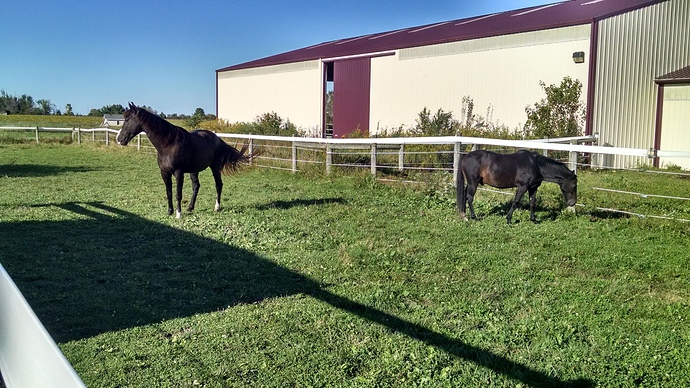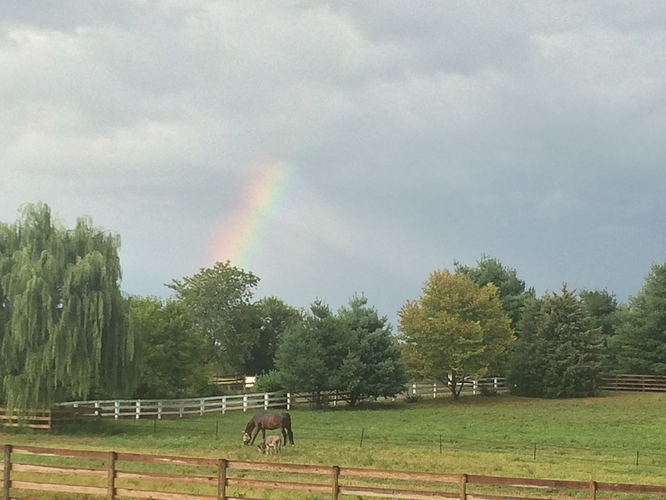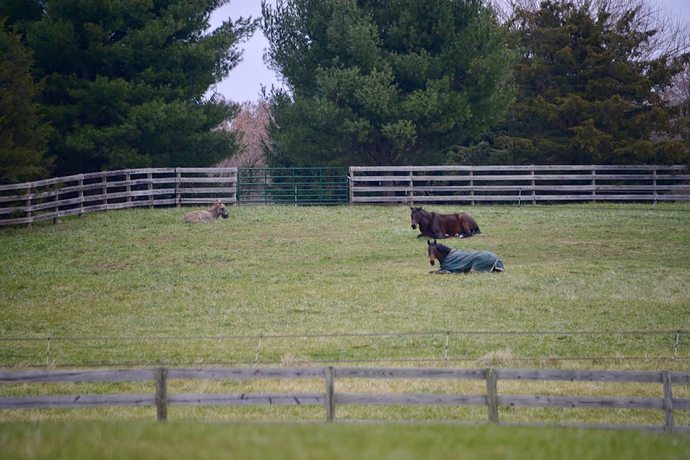When I had 4 horses on 5 acres I used to rotate between two pastures to keep the grass going all summer. Now I’m down to 2 horses on the 5 acres and I’m wondering if rotation grazing is necessary or if I can just open up both pastures full time? I will continue to mow the grass and harrow throughout the year. The reason I’m asking is because if I rotate I’ll have to set up electric fencing to facilitate that. I hate the look of the fencing so I’m trying to avoid that this year.
IMHO, it depends on how pretty you want your pastures & how much grazing you expect to supplement forage fed.
I’ve kept 2 horses on roughly 1/2 my 5ac - allowing 1ac+ for house, gardens, lawns & the L-shaped mini-hayfield surrounding barn & pastures.
For the past 6yrs, 1 horse, 1 pony & 1 mini.
I only rotate by closing off the larger pasture (~1ac) when Spring grass is a threat to the mini.
I feed hay year-round, but a lot less when both pastures are open & grass is in.
Pastures get bushhogged in the Fall, no other maintenance is done.
They are never what you’d call “lush”, but keep the herd happy.
Mid-Summer on the smaller field:
I would continue to do rotation grazing. Personally, I would split pasture into 4 pieces, so the horses grazed it more thoroughly, not just their favorite spots. Then move horses into the next field section after a week, mow the one they left to cut off weeds. You might need to mow resting fields if they grow a lot between grazings, to keep height at 5 to 8 inches. You do not want grass going to seed. Seed production makes grass go dormant, no growth.
But a week grazing on each section lets the other sections rest, regrow even the “tastiest” parts, before horses return. And if things get drought stricken, you will have grass to spare! Just rotate sections sooner. I do that during drought times, so they always have grazing. Rest might only be a day or two here, but grass will grow a bit to be grazed again. I do have clay soil which holds moisture well under the turf. Long rooted plants manage well enough to continue growth, with the rotation plan. I am grazing numerous horses on small acreage, Mine are stalled half the day, which helps grass not be overgrazed or killed off. Mine are easy keepers, so we feed very little hay during summer. They look great on pasture and a bit of grain.
Electric fence is not always a favorite “look.” But it helps keep your pastures producing well, so horses always have a bit of good stuff to nibble. Large, open fields get grazed very unevenly, with the favorite places turning into bald spots. Other taller places get ignored because horses like tender new growth, not old tough stems.
Mowing by grass height helps a lot, no shorter than 4-5 inches to protect the roots and soil. Cut as grass gets up to 8-10 inches or starts going to seed. Height or seeds is your best indicator of needing mowing, over timed mowing of weekly or every 10 days. Rains accelerate growth, so i might need to mow everything weekly in Spring to keep it shorter. While being dry can stretch out time between mowings. I don’t mow if it appears we are going into drought.
You can always try opening it all up for a year and see how it goes. Personally I would keep rotating because I’ve found it to make a huge difference in pasture/land health. I like allowing the choice spots time to recover so they’re not always grazed down to nothing, and encouraging more consumption of the roughs.
What kind of electric fence are you using? I find brown Horseguard tape to be fairly inoffensive to the eye. (It would be even more inoffensive if DH and I were capable of driving T-posts in a straight line, but our view from the house is side-on so mostly we can’t see how “artistic” the lines are.)
ETA a few photos of unobtrusive electric fence:
I ran 2 horses and a Shetland pony on a 6 acre field 24/7 for 3 yrs with no issues. I had to feed hay in the winter of course.
Would the field have looked better rotated? Would I have had more grass if it was rotated? Sure. Was the field harmed by continuous grazing? Nope.
My then young horse benefited more from the open space imo. Plenty of room for big gallops. The Shetland also benefited from trying to keep up with said gallops.
YMMV
I have 2 horses on about 18 acres of pasture. The 18 acres are divided into 3 fields (~2 acres, ~6 acres, and ~10 acres). In the winter the horses are on all 18 acres. In the spring and early summer I confine them to the small field because it’s easier to keep mowed. In spring, summer, and fall we rotate cows through the two larger fields and turn the horses out on each field when the cows are gone. We also bushhog the fields mid to late summer.
I like to give my horses a lot of room to run, and there’s nothing more glorious than watching them race around the perimeter of all 18 acres. On the other hand, I worry about them running into the fence when they run in the little field. Having more room to roam keeps the manure spread out enough that it doesn’t foul the field, and alternately resting the larger fields gives the manure time to decompose.
@Weezer, since you’re going to continue to bushhog and harrow the field you could just let the horses roam as they want. If the field starts to look ragged or overgrazed you could put up electric fence then.
Thanks for the input, everyone! I think I’ll start with rotating between the two existing fields and see how that goes. I mow regularly to keep the grass short because ticks are a huge problem here. I provide hay during the summer. But it just gets picked at.
I think that’s your best bet. Do you pull them off the pasture in the winter? I have the same amount of pasture as you, and two horses and have it split in two. I give them access to the back pasture a few months longer into the winter than the front, and then pull them completely off grass from January-April or May. I switch between fields as needed, no set time, more just by how eaten down it’s looking. I dry lot overnight (one is a fattie) but by doing this they have plenty to graze for 7 months out of the year.
If you keep it as one big area, I’m sure you’ll still have enough grass, it’ll just be eaten down in areas and you probably won’t have as lush of pastures. Its up to you, but I think splitting it is a wise idea.
I have two small horses on probably 2.5 acres, split into 3 paddocks. I prefer to keep them separate as the young one harasses the older one. For most of the year, I only use two of the paddocks, they’re out 24/7 and during summer, the paddocks need to be mowed while the horses are on them as they just can’t keep up with the grass (plus one gets fat very easily). Through winter I have to supplement a little with hay, but unless it’s a particularly dry year, they don’t need alot of hay, the paddocks hold up pretty well and as soon as we get the first summer rains they bounce back quickly.
I use the third paddock mainly to get them out of the wet stuff, as it’s further up the hill and stays drier. The main paddocks have the dam overflow run through the middle so when we get alot of rain, there’s a section through the bottom that just gets super muddy and sloshy and takes forever to dry out.
In a perfect world I’d split each paddock into two, but that would require building 3 extra shelters, running pipelines etc so not really feasible at this time.
I had just one horse on the same for many years before getting the second, and she basically had access to the lot 24/7, most of the time there wasn’t a real need to rotate.
 I minimize line deviations by laying out the tape first, pulling it as taut as I can for the given length (which is still pretty straight even if it’s 500’), and then put posts in by that.
I minimize line deviations by laying out the tape first, pulling it as taut as I can for the given length (which is still pretty straight even if it’s 500’), and then put posts in by that.
I have 3 horses on 4.5 acres and they can’t eat it all. We usually mow it once when the grass gets tall in places/ goes to seed . If you have a good stand of grass it would be so much easier to just let them do as they please.
somehow I keep having that mental picture of horses standing on a rotating platform to graze…1930s era fun house stuff…
Alas.
what do you expect from the pasture, performance wise? Do you expect the horses to move freely and exercise? It will be less than one expects, unless their daily demands are met in spaced out stations, from water to hay to rolling/sleeping ares.
The grass depends on where you are and your local climate. Expect the gate areas to go to crap rather quickly.
Other than that, give it a try.
If you see it does not work out for whatever reason, the electric fence is quickly erected.



